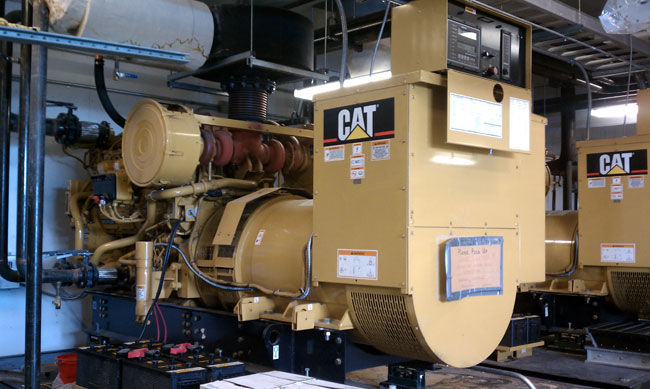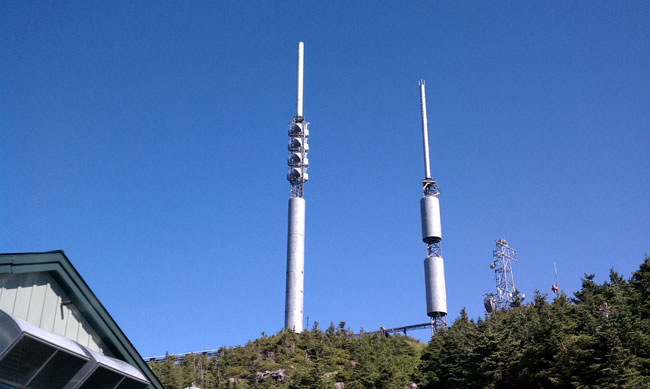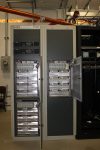As alluded to in the previous post, I spent a fair amount of time at Mt. Mansfield last month. It is the highest point in the state of Vermont, topping out at 4,393 feet (1,339 M). At the top, there is a large transmission facility that is home to WCAX-TV, WPTZ-TV, WVPS, WEZF, several low-power TVs, NOAA weather radio, etc. Next door, Vermont Public TV is housed in a separate building. Here are a few pictures and descriptions. First of all, Mount Mansfield is the home of the Stowe Ski area. They own the access road to the top of the mountain and are quite proud of it. In the summertime, the toll for a carload of people is $26.00.

The transmitter building is below the actual peak. This is one of the few transmitter sites that is manned 24/7, as such there is a working kitchen, bathroom, bunk rooms, and so on. I’d imagine it gets pretty deary up there in the wintertime, but perhaps not.

The transmitters are located along a long hallway. WEZF and WVPS share a room, and WCAX and WPTZ are in open bays as are the low-power TVs. NOAA weather radio and some other government transmitters are located in the garage.

All of the TV transmitters are new because of the recent conversion from analog to digital transmission. WCAX is noted as channel three, which was their analog channel, they actually transmit on channel 22 with a power of 443 KW ERP.

Like WCAX, WPTZ was on channel five, it is now transmitting on channel 14 with 650 KW ERP.
The site is backed up by two 1.2 MW diesel generators, which can be paralleled with the commercial power grid, if needed, during peak demand times. These generators also provide backup power for the Stowe Ski area. There is a 50 KW back up back up generator that runs all of the emergency transmitter cooling equipment if the two main backup generators fail.

All of this generating equipment requires a lot of fuel.

The TV and FM broadcast antennas are located just below the peak

I don’t recall which TV station belongs to which antenna. The FMs are combined into the four-bay, three-around panel antenna, this includes WVPS’s HD radio signal.

From the very top looking west into the aperture of the TV antennas. I only stood there for as long as it took to get a good picture, then departed. Off to the left of this view is the antenna for Vermont Public TV.

The transmission lines go down the hill on a large ice bridge. An absolute necessity as the rime ice can sometimes accumulate several inches.

Tower base, is the location of the highest RF concentration, according to the TV engineers. I only lingered here to snap a few quick photos.

All of the STL antennas are mounted to the side of the transmitter building next to the living quarters.

On top of all that, as if that weren’t enough, there is the view. I would also comment a bit on the weather. In some cases, the site can be completely engulfed in a grey dull fog bank one minute, then the wind changes direction, the sun comes out and you see this:

I can think of worse things.
I regret that I didn’t have a better camera with me as several of the pertinent pictures came out blurry. All of these pictures were taken with my cellphone camera, which works well when it works. It is also very convenient because it is almost always with me and I don’t have to remember to bring another gadget. However, it this is going to be a semi-serious endeavor, I will have to take some of my earnings from these scribblings and buy a good camera.






I like your site. However, I do have a minor complaint about the transmitters. I wish they had built one massive tower and put all the TV channels on it instead of the current setup. You only have to see the tower on Mount Royal in Montreal to see what I mean. It is very difficult to pick up all the stations there on Mt. Mansfield equally especially the under-powered ones. I will have to look for a new antenna in the spring to compensate for this shortcoming. WVNY is totally off the radar here and WFFF is in and out.There should be a minimum power output of at least 100 or 200 kw for TV stations, and why not 650 kw like WPTZ ? I have been watching digital TV since the end of August here when Canada made the switch-over and have been unimpressed with the reliability with your transmissions with the exception of WPTZ and VPT. Other than that, your photography is very good, except next time take along a bonafide digital camera.
So we are ready to ditch DishNetwork due to many issues with the company and I was hoping to go back to free tv. Why can I get channel 3 but not the other stations? I bought a high gain uni directional antenna as the engeenier suggested. When HDTV first came we got all the stations, now just 3, why?
Well, I put up that new antenna and I still don’t get WVNY 22 , omly once in a blue moon when atmospheric conditions boost all the signals. WFFF 44 is a major disappointment as well, no sign of it at all. Kudos to VPT, their signal is the most reliable despite the fact they are much less powered that WCAX and WPTZ. Maybe they have a better antenna ? WCAX has been coming in a bit more poorly lately, perhaps I can tweak my antenna a bit. It’s a frustrating situation not picking up 22 and 44 since I got fed up with the high monthly bills and dumped my satellite. E-mails to FOX have not been returned. Why isn’t there a standard as regards to signal output to ensure adequate reception ? Why is WVNY transmitting on 13.1 when they were offered 16.1 by the FCC ? There are no less then 6 channel 13’s here in Canada in a 300 mile radius. WVNY is putting out a measly 10,000 watt signal ensuring no reception up here.
Robert, and others, a couple of things to note about this transmitter site, and understanding power levels and such.
Broadcast TV, like Broadcast FM operates on a “line of sight” theory. (It’s much more complex than that, but that is the simplest way to put it for now.). Because of this, the FCC sets a maximum power, at a maximum height. If you go beyond that height, the power level drops, as the actual “footprint” will remain the same. It is why radio stations on the Empire State Building in New York City operate at 6,000 watts, but have signals equivelant to 50,000 watts. WVNY may “only be 10kW”, however they are 10kW at over 830 meters above average terrain. That signal is equivelant to the maximum power allowed by the FCC for VHF channel 13. Now as to why WVNY chose 13 versus 16 (and for the record, they transmit on 13 and 16, not “13.1” or “16.1”. The PSIP table is 22.1, but the actual RF slot and program number are 13.3). There are several advantages to being on VHF, especially in mountainous Vermont. First off is better signal propogation. VHF does better in hilly terrain than UHF does. Second is cost. A VHF solid state transmitter for 10KW costs a lot less to run than for 800KW UHF.
Now as for the varying power levels and antennas, it all has to do with design. Antennas have different patterns, power levels. To combine everyone into one massive antenna, would require a much bigger UHF antenna system, a lot beefier tower design, and it puts the entire television market into an “all the eggs in one basket” scenario. Stations operate at different power levels because certain channels have to “protect” other channels and services. Both in the US and Canada. For instance, WCAX on UHF 22 has to protect a UHF 22 assignment in Springfield, MA. If Burlington where the only market with the only stations in existance, then they could all just operate at a uniform power level. But unfortunatley they can’t due to other stations.
As for your reception issues, there are a few things to note. I don’t know where you are in Canada, but make sure you have an antenna that is rated for both VHF and UHF useage. The higher up and more directional, the better. Also, depending on where you are, if you have a pre-amp, you may want to toss it. I’ve found with DTV reception, (as with most RF reception), pre-amplification does more harm than good, as it increases the noise floor, which is more detremental. The five stations being on different towers makes no difference, as they are all within .2kM of each other. The differences in reception are due to channel assignment, “local interference” (Items in your house that can interfere), power level, and other factors. If you are emailing Fox TV network, that won’t help much, as they don’t respond for local station’s support.
Hope some of this helps.
— Mike Fitzpatrick
TV Engineer in Rhode Island w/ 2 VHF DTV stations.
NECRAT.us webmaster
Nothing wrong with my antenna, it’s a brand new Channelmaster CM 2020. for channels 7 to 69. The problem is strictly the fault of ABC and FOX. Their transmitters are at a lower overall height than the others there and at lower power. It’s a mystery to me why some major U.S. networks can’t afford some decent equipment! It’s like a Keystone Cops operation there.
I don’t how the FCC or Industry Canada decide on which channel a tv station can operate, but they made a few errors in this area. They gave 22 to WCAX in Burlington and 21 to CBMT in Montreal. There are plenty of unused channels in this area and stations side by side invites interference. They made the same error with WVNY putting it on 13. There Is channel 12 in Montreal and several other channel 13’s in Quebec. Shouldn’t the “Powers That Be” be concerned with providing adequate reception for all concerned ?
I have recently learned that WFFF FOX 44 is deliberately not transmitting to the north and west and concentrating on the south and east. That would explain why there is no reception in most parts of Montreal. Their signal would be picked up here otherwise. Perhaps it’s the quality of their antenna. PBS is doing an excellent job with their setup. WCAX continues to be the lesser performer here compared to PBS and NBC due to the fact that the CBC station in Montreal CBMT decided to transmit on channel 22 and have recently increased their power. With so many other channel choices in the area, it doesn’t make sense that they chose 21 knowing full well that it would cause interference to WCAX.
Same issue from east end Montreal. CBS, NBC, PBS are excellent. Poor signal from ABC (WVNY) and FOX (WFFF). I use to be able to catch WFFF last year (spring 2013). Something changed?
I live in Montreal East also and I have been told that channel 44’s signal is being directed away from us . No combination of antennas seems to work, I’ve tried everything. My friend in Ville St. Laurent gets them though.
PBS is adding a second high definition channel on 32.2 and from what I’ve seen, there is no loss in picture quality from 32.1. Both channels are stunning ! It remains to be seen when the other networks on Mount Mansfield start transmitting four or more channels.
I tried a Winegard 2 antenna coupler for my 2 Channelmaster antennas in a last ditch effort to pull in 44. No luck, although it did bring in WCAX with a stronger signal, I lost a local channel ! I had better performance with a Channelmaster splitter. I ended up removing the coupler and taking down the 2nd antenna. There is no 44 signal in my part of Montreal to pull in. All other stations on Mount Mansfield with the exception of WVNY ABC 22 and FOX 44 of course come in beautifully. WVNY was great when it was analog but became a no-show when it went digital. Kudos to CBS, NBC and PBS on their performance.
Robert,
You’ll get better results to your questions/complaints about reception in the AVSforum.
http://www.avsforum.com/f/45/local-hdtv-info-and-reception
— Mike
“DUDE! Enough already! One more ridiculous comment about TV reception in Montreal and you’ll be banished…You’re in Canada, watch the CBC for #$^& sake”. Hahahaha.
Robert, Try a DB4E antenna. I’m getting better reception (CBS, NBC, PBS) with a DB4E. FOX is weak, but with an amplifier, it might be ok. I haven’t found anyone selling a DB8E here in Montreal. Reception should be even better with a DB8E antenna. ABC signal strength is just too weak (www.tvfool.com charts confirm this)
Mt Royal is preventing a 2nd PBS station Ch 57.1 from getting through. I believe this signal is coming from Plattsburgh.
Good luck!
Mike, thanks for the avsforum site.
-A CBC watcher, Go Habs Go!
That Paul Thurst told me to write my congressman. We don’t have congressmen in Canada! There are more viewers of American channels in Montreal than in New York, New Hampshire and Vermont combined ! Vermont has a large donor base in Canada, at least they put out a signal we can get.
Jay B. Yes, the signals are weak for FOX and ABC , but they’re not too weak for Videotron ! Get my drift ?
Paul Thurst, Ni ta ma de Hindan !
Robert, Paul knows you don’t have a congressman. 🙂
I doubt they tell US stations lower their signals to get more business. They might be smart enough to pay some stations do that. Who really knows?
I’m not to worried about what Videotron does. They have problems of their own. They are losing customers. Bell Fiber is growing in Montreal.
The PBS, ABC, CBS, FOX stations for Bell are from NY city. Canadians can watch those stations. Vermont businesses lose out, not us.
The situation benefits the cable company either accidentally or by design. They have expensive equipment to overcome the shortcomings of the weaker stations. FOX 44 has been watchable the last couple of mornings averaging 20 to 80% signal strength. Must be atmospherics, even ABC 22 was viewable for a short time. I watched FOX news in the mornings and judging by the sets they use for their newscasts, they are operating on a very small budget. That would explain the weak signals, it’s not the fault of the antennas, yours or mine. I’ve been in contact with Channelmaster and there’s nothing wrong with my antenna.
They told me that if 32 (PBS) is coming in strong then 43(FOX) should be strong as well unless they are weak. I wonder how they are picking up our signals down there?
The cafe owner across the street from my store went from Bell satellite to Bell Fibe and commented that the picture was worse ! She has seen the picture quality of broadcast tv and is amazed by it, the best HD picture found anywhere.
Hi everyone,
First things first:
Just installed a DB8E antenna on my 2nd floor condo balcony and all stations from the US are coming in, except FOX. Yes, WPTZ comes in, but it will come and go once in a while. I should say that I’m on the North shore, close to the Highway 640 and Highway 25 junction.
DB8E is nice as you can beam one towards the Mount-Royal (e.g. Local transmission tower) and the other to Mount Mansfield. I’m lucky that in that general direction there’s a park and I have at least 300m before the next building.
As for those who are unhappy about some channels not being available in Canada, blame the CRTC, not the FCC. CRTC dictates that “non-canadian” signals may not interfere with Canadian signals. I’m sure that the FCC has rules similar.
Yes PBS comes in nice and clean, but they are PUBLIC, meaning that they do need people to fund them, and many of their contributors are north of the border. Since they are public, CRTC rules are a bit less stringent.
On the other hand, CBS, FOX, NBC and the likes are PRIVATELY OWNED and most, if not all of their budgets come from publicity. Have you seen anyone in Canada buy a new car in Vermont or use a product only available in the States…NO. Sorry to say people: Money Talks, shit walks, so does the signal to this side of the border.
I’ve cut the Videotron cable for TV and saving over $80 a month. I cut the Videotron Internet 6 months back to another “local” internet provider who gave me the same bandwith and speed for almost half the price USING VIDEOTRON INFRASTUCTURE! Savings of $25 a month. I cut Videotron home phone for NetTalk a year ago: Savings about $16 a month. Guess what? Videotron still does not have a clue why I cut the cable.
By cutting out Videotron, that’s more $120 a month in my pocket…nearly $1,500 a year (and I need to bring in $2200 gross pay to get that amount net)
Guess what, not getting FOX is not that big a deal after all… And If I really want to see a show, I’m sure I can find it on my cheap High speed Internet 🙂
Cheers all!
Al